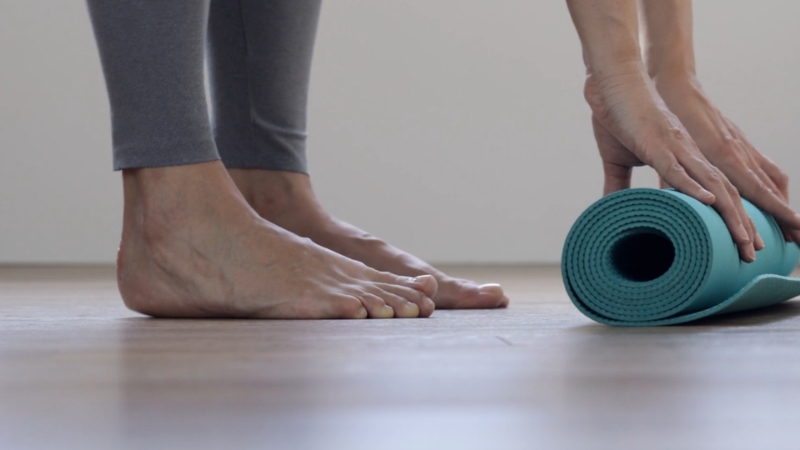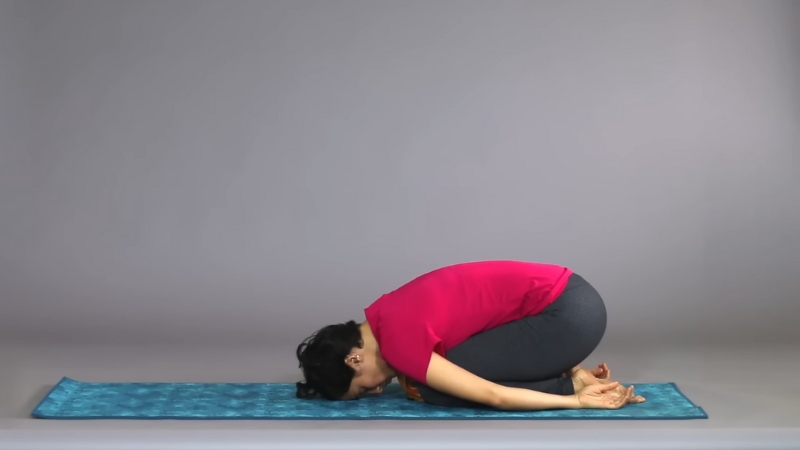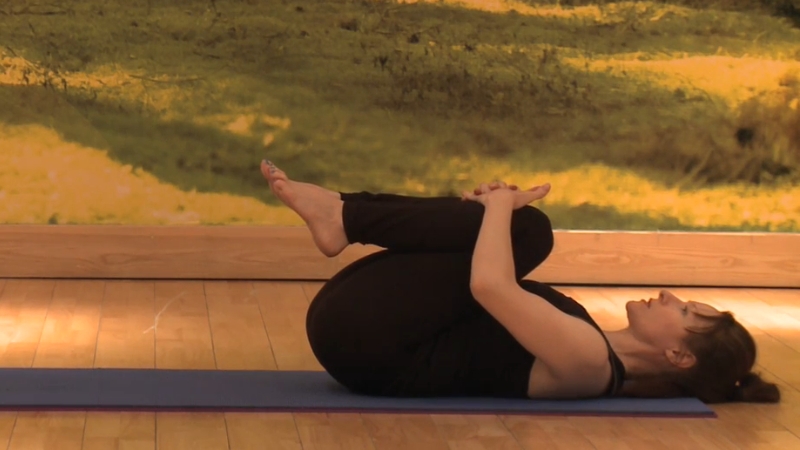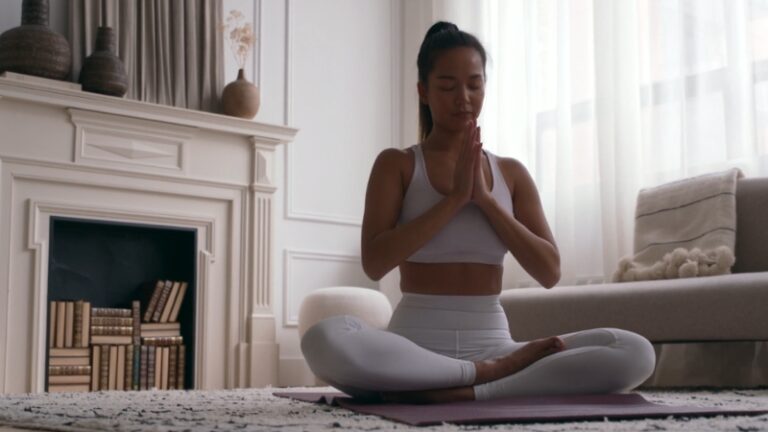Menstrual cramps – medically known as dysmenorrhea – are among the most common gynecological complaints. Studies suggest that up to 84% of women experience menstrual pain at some point, and for about 1 in 4, the pain is severe enough to interfere with daily life.
The usual solution is over-the-counter medication like ibuprofen, but research shows that yoga can be just as effective for many women without the side effects.
A systematic review in the Journal of Alternative and Complementary Medicine (2011) and multiple clinical trials since then confirm that regular yoga practice reduces the intensity, duration, and emotional impact of cramps.
The best results come from specific poses that open the hips, stretch the lower back, and activate the parasympathetic nervous system – the body’s natural “rest and repair” mode.
Why Yoga Helps with Menstrual Cramps

Yoga influences both the physical and hormonal mechanisms behind menstrual pain. During menstruation, the uterus contracts to shed its lining.
These contractions are triggered by prostaglandins, hormone-like chemicals that, in excess, cause stronger cramps, back pain, and even nausea.
Regular yoga practice works on three levels:
- Musculoskeletal relief – gentle stretches release tension in the hips, back, and abdomen, directly targeting the muscles most involved in menstrual pain.
- Circulatory improvement – certain postures increase blood flow to the pelvis, which helps reduce congestion and oxygen deprivation that worsens cramps.
- Nervous system regulation – restorative yoga calms the stress response, lowering cortisol and increasing endorphins, which improves pain tolerance.
In addition, yoga incorporates deep, controlled breathing (pranayama), which further supports oxygenation and stress relief.
When combined, these effects explain why multiple randomized trials report up to 40–60% reduction in menstrual pain intensity after a few weeks of practice.
Science-Backed Yoga Poses for Menstrual Cramps
Below are the most studied and effective yoga poses for menstrual discomfort, with details on how they work and the scientific evidence supporting them.
1. Supta Baddha Konasana (Reclined Bound Angle Pose)
This restorative posture involves lying on your back with the soles of the feet together and knees gently falling outward. A cushion under the spine can add support.
- How it helps: Opens the hips, softens abdominal tension, and promotes relaxation. It also helps relieve lower back strain.
- Scientific evidence: A 2016 study published in the Journal of Evidence-Based Complementary & Alternative Medicine found that restorative poses like Supta Baddha Konasana significantly improve comfort and reduce perceived pain during menstruation.
Benefit
Mechanism
Evidence
Hip opening
Releases pelvic tension
Yoga trials on dysmenorrhea
Abdominal relaxation
Reduces uterine spasm
Complementary medicine reviews
Nervous system calm
Lowers cortisol
Autonomic balance studies
2. Balasana (Child’s Pose)

Balasana is one of the most grounding yoga postures. Kneeling with the torso folded forward, it gently compresses the abdomen.
- How it helps: Provides soothing pressure on the pelvic region, stretches the spine, and relieves stress-related cramps.
- Scientific evidence: Research in the Journal of Pediatric and Adolescent Gynecology (2017) highlighted that mind-body relaxation through poses like Balasana reduces the severity of dysmenorrhea in adolescents.
Effect
Why It Works
Abdominal compression
Massages the pelvic organs and eases cramps
Lower back relief
Stretches spinal muscles strained by pain
Mind-body relaxation the n
Reduces perception of pain intensity
3. Setu Bandhasana (Bridge Pose, Supported)
View this post on Instagram
When practiced with a yoga block or cushion under the sacrum, this pose becomes highly restorative.
- How it helps: Gently lifts the pelvis, improving blood flow, relieving pelvic congestion, and stretching abdominal muscles.
- Scientific evidence: A clinical trial in the Journal of Clinical & Diagnostic Research (2013) showed that students practicing Bridge Pose and similar asanas reported significant relief from menstrual cramps compared to non-yoga groups.
Benefit
Mechanism
Pelvic circulation
Elevates hips, reduces stagnation
Abdominal stretch
Counteracts tightness from contractions
Gentle inversion
Promotes hormonal balance
4. Apanasana (Knees-to-Chest Pose)

Lying on the back with knees pulled toward the chest, this pose is often called the “wind-relieving posture.”
- How it helps: Relieves bloating, improves digestion, and gently massages the uterus and intestines, reducing cramps.
- Scientific evidence: Frequently included in yoga therapy for dysmenorrhea, with reports of reduced abdominal pain due to improved circulation and muscle relaxation.
Benefit
How It Helps
Abdominal pressure
Eases uterine cramping
Digestive support
Reduces gas and bloating linked to the cycle
Relaxation
Promotes parasympathetic activation
5. Supta Matsyendrasana (Supine Spinal Twist)
@yogawithkatharine I wish more people knew about these benefits of this yoga pose called supine twist! #yoga #yogapractice #yogapose #supinetwist #yogatwist ♬ original sound – ⭐️
This pose involves lying on the back and gently twisting the knees to one side while extending arms out.
- How it helps: Relieves spinal tension, improves pelvic blood flow, and stretches the abdominal area.
- Scientific evidence: Twisting postures improve vagal tone, which enhances parasympathetic activity and reduces pain perception (Pain Research & Management, 2018).
Effect
Reason
Spinal release
Loosens lower back tightness from cramping
Pelvic circulation
Enhances blood supply to the uterus
Nervous system calm
Supports pain relief through vagal stimulation
6. Viparita Karani (Legs-Up-the-Wall Pose)

One of the most restorative yoga poses, Viparita Karani, involves lying on the floor with legs extended upward against a wall.
- How it helps: Encourages deep relaxation, reduces swelling in the legs, and relieves pelvic heaviness.
- Scientific evidence: Restorative inversions have been shown to balance the autonomic nervous system, improving comfort during menstruation.
Benefit
Mechanism
Pelvic drainage
Relieves pressure and congestion
Nervous system balance
Reduces stress response
Circulatory boost
Improves blood and lymph flow
Complementary Role of Nutrition
Scientific studies emphasize that yoga is most effective when combined with balanced nutrition. For example, diets rich in magnesium, omega-3 fatty acids, and vitamin B6 reduce the frequency and severity of menstrual cramps.
Magnesium (found in leafy greens, nuts, and seeds) helps muscles relax, while omega-3s (from flaxseeds, salmon, walnuts) reduce prostaglandin production.
Women with higher nutrient intake consistently report milder cramps. For structured resources on diet and muscle health, you can find detailed information on nutrition science here.
Final Thoughts

Yoga is not a miracle cure, but it is one of the most effective non-pharmacological approaches to managing menstrual pain. Unlike medication, which only temporarily, yoga addresses the muscular, hormonal, and psychological components of dysmenorrhea.
Even short, restorative sessions practiced three to four times per week can reduce pain intensity by up to half and improve emotional well-being during the cycle.
For women looking for sustainable relief, a simple routine of Supta Baddha Konasana, Balasana, Apanasana, and Viparita Karani can make periods more manageable without relying solely on painkillers.

